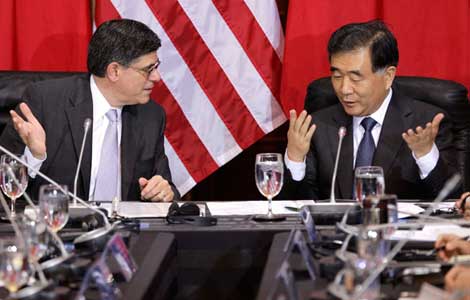Global clearing system sees delay
Updated: 2013-07-13 08:27
By Wang Xiaotian (China Daily)
|
||||||||
China will postpone the launch of its new international payment system, although some basic functions will be available by year-end, said a senior executive at the State-owned Bank of China Ltd on Friday.
The system, known as the China International Payment System, is being developed to facilitate cross-border yuan clearance among market players and further boost the global profile of the Chinese currency.
Zhang Lei, general manager of global payments and clearing at the bank, told a news conference in Beijing that overseas institutions would not be allowed to connect with the system in the first phase, because time-zone differences might cause liquidity management problems.
The "primary" or "basic" functions that would be available by year-end include opening accounts and processing payments, he said.
"The second phase would involve some global clearing participants," Zhang said.
"The launching of CIPS will help form a multi-layer, cross-border yuan settlement and clearing system and encourage overseas institutions to open accounts in China."
But the existing methods of yuan clearing, which involve a clearing or agent bank, will survive, because there are requirements and costs associated with joining CIPS, according to Zhang.
"For small and medium-sized banks, or banks with lower yuan transaction volumes, choosing offshore clearing banks would still be a more practical and economic way."
Beijing has been accelerating its drive to float the yuan globally. The People's Bank of China, the central bank, announced on Wednesday a set of measures to loosen controls on cross-border yuan flows under both the current and capital accounts.
Under these measures, domestic companies can apply to domestic banks to disburse yuan overseas, while multinational companies can utilize a yuan capital pool framework to do the same.
In addition, qualified domestic banks can provide yuan-denominated financing to foreign banks for as long as one year, against a previous limit of only one month.
"Overall, we believe these measures will help provide yuan liquidity from the Chinese mainland to Hong Kong and other areas overseas, further promoting the internationalization of the currency," said Zhang Zhiwei, chief China economist at Nomura Holdings Inc.
As of the end of May, about 11 percent of China's total trade was being settled in yuan.
A survey conducted last month by Bank of China showed that more than half of its nearly 3,000 domestic and overseas clients believe the proportion will eventually reach 20 to 30 percent.
Among overseas respondents, 61 percent said they plan to increase the proportion of yuan settlements in their trade transactions.
But the survey also found that 90 percent of all yuan settlements were related to companies located in the mainland or those with a mainland background.
"That means only 10 percent of yuan settlements were conducted between overseas third parties, among which most were companies from Hong Kong and Macao," said Cheng Jun, general manager of the corporate banking unit at Bank of China.
Nearly 80 percent of the respondents said they use the yuan simply because they have trade relations with the mainland and would like to settle transactions in the currency.
Most overseas clients ranked a stable exchange rate first among the factors that would affect their choice of using the yuan.
Nearly half of the respondents said there are only one or two banks that could provide yuan services locally.
Cheng said the findings suggest that prospects for the yuan's internationalization are still bright, but the breadth and depth of the market need to improve.
"For example, the figures indicate the global use of the yuan is still driven by trade settlement demands, and the pricing function of the currency is already lagging far behind."

 Coca-Cola seeks to connect with young customers
Coca-Cola seeks to connect with young customers
 Inscriptions may predate oracle bones
Inscriptions may predate oracle bones
 Residents flee from landslides
Residents flee from landslides
 Tourists say they aren't afraid to travel in Xinjiang
Tourists say they aren't afraid to travel in Xinjiang
 Summer lights
Summer lights
 BASE jumpers celebrate their annual event
BASE jumpers celebrate their annual event
 S Korean students mourn Chinese victims of air crash
S Korean students mourn Chinese victims of air crash
 Constructive mood at talks
Constructive mood at talks
Most Viewed
Editor's Picks

|

|

|

|

|

|
Today's Top News
Snowden seeks political asylum in Russia
3rd Chinese girl dies of injures in Asiana crash
Key investment negotiations to restart
More women turning to abortions
IT push to boost domestic demand
Chinese companies in the US go on talent hunt
Nokia aims to recapture market
Samsung expands global footprint
US Weekly

|

|






